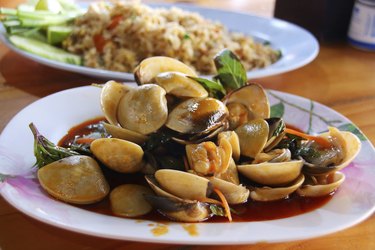
Many clams have tough protein fibers that cooks need to break down to make the meat palatable for use, especially in a chowder. In general, the larger the clam, the tougher the flesh. Not all clams need pounding, however. Large hard shell quahogs require tenderizing; whereas, soft-shell steamers are usually good to go without any interference.
Initial Preparation
Video of the Day
While most store-bought clams are ready to tenderize, those that are dug from the shore need to be cleaned first, ideally by soaking in brine overnight. Whether they are soft or hard shell, clams must be alive before tenderizing or cooking. Discard any that remain closed after blanching or that do not close tightly when raw if tapped with a knife. Prize open clams on a hard, non-slip surface by working open the shell with a sturdy knife. Remove the guts and rinse off any sand; then spread out the meat, which will include a soft main portion and extending parts such as the foot and siphon. Lay the meat flat on a board, ready for tenderizing.
Video of the Day
Light Pounding
Hammering away at clam meat with a chef's mallet physically disintegrates the protein fibers in the same way as tenderizing a steak. To protect the clam's integrity, lay the strips of meat between plastic wrap to avoid splattering the surface, and use the smooth side of the mallet. For long, straight razor clams, a delicacy from the West Coast, pay particular attention to the tougher meat of the siphon. The same applies for the geoduck clam, which has a substantial siphon. The geoduck must be blanched in boiling water for 10 seconds before you try to open the shell. Split the siphon along its length with a sharp knife and hammer it until it is less rubbery, ready for slicing and sauteing. The soft body meat of the geoduck, however, does not require tenderizing and can go straight into a chowder.
Clam Types
One of the most recognizable clams, the quahog from the East Coast, has a notoriously tough, chewy flesh. A light pounding is sufficient to prepare the meat for frying in a po' boy, but for use in chowder, the clam needs to be on the smaller side, as the large ones are too tough. Few small-sized clams need any tenderizing and can be eaten straight from the steamer, although a wine marinade with a dash of lemon juice makes the flesh more succulent. Both Manila clams and littlenecks can be steamed and served straight; whereas, horse clams benefit from manual tenderizing around the neck and rim, where the flesh is tougher.
Natural Marinades
Both papaya and pineapple juices contain enzymes that are effective in tenderizing not only meat but also shellfish, although bromelain, the active ingredient in pineapple juice, can turn clam meat into mush if they're left in it too long, so check it regularly. In both cases, soak the chopped clam portions in the juice and any seasonings, cover, and refrigerate. Buttermilk, too, has a tenderizing effect and prepares the clam for dredging in breadcrumbs, but it's less acidic than citrus marinades, which can actually make clam meat more chewy. Soak the chopped clam meat in buttermilk for up to 30 minutes, depending on the thickness of the chunks, shake off any excess, and toss it in breadcrumbs.
- What’s Cooking America: Fried Razor Clams
- Cook’s Thesaurus: Shellfish
- Washington Department of Fish and Wildlife: Cleaning and Preparing geoduck
- South Whidbey Record: Come out of Your Shell, All Clams Are Not Created Equal
- The Kitchn: What’s the Difference? Little Neck, Cherry Stone, Top Neck and Quahog Clams
- Star Chefs: Razor Clam Po’ Boy with Apple Cabbage Slaw on House-made Ciabatta
- USDA: Agricultural Research: Oysters, Clams and Mussels
- Clams Ahoy!: Quahog Clams
- The Taste of Oregon: Razor Clams -- Succulent, Scrumptious Clam Steaks
- The Reluctant Gourmet: Clams
- Esquire: How to Tell Your Clams Apart
- BBC Food: Clams
- Man and Mollusc: Clams
- Inland Seafood: Clams, Geoduck
- Fine Cooking: Marinades Add Flavor but Don’t Tenderize
- Enzyme Development: Meat Tenderizing Enzymes
- PBS: Learn Three Techniques for Tenderizing Meat